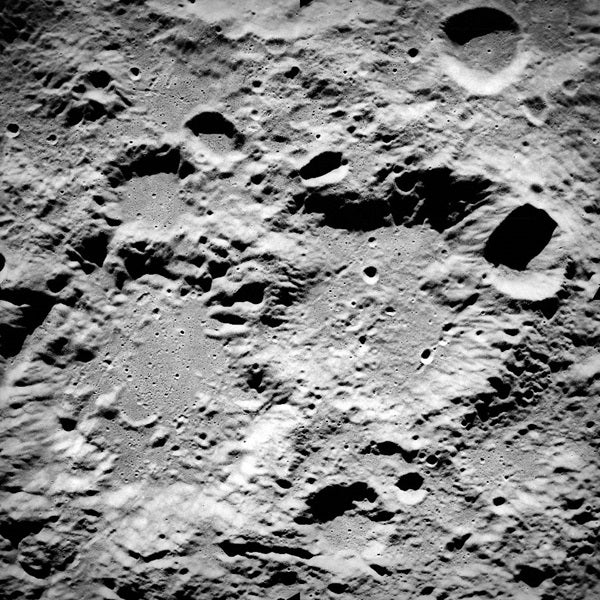N early 40 years after man first walked on the Moon, the complete lunar photographic record from the Apollo project will be accessible to both researchers and the general public online. A new digital archive — created through a collaboration between Arizona State University and NASA’s Johnson Space Center in Houston — is making available high-resolution scans of original Apollo flight films.
The digital scans are detailed enough to reveal photographic grain. Created from original flight films transported back to Earth from the Moon, the archive includes photos taken from lunar orbit as well as from the lunar surface. This is the first project to make digital scans of all the original lunar photographs from NASA’s Apollo missions.
“This project fulfills a long-held wish of mine. It’ll give everyone a chance to see this unique collection of images as clearly as when they were taken,” says Mark Robinson, professor of geological sciences in ASU’s School of Earth and Space Exploration, part of the College of Liberal Arts and Sciences.
Robinson leads the ASU side of the Apollo image digitizing project. Separately, he is the principal investigator for the Lunar Reconnaissance Orbiter Camera (LROC) — a suite of three separate, high-resolution imagers on board NASA’s Lunar Reconnaissance Orbiter, due for launch in October 2008.
The reason the original Apollo images have been so seldom accessed is that they are literally irreplaceable. Between 1968 and 1972, NASA made sets of duplicate images after each Moon mission came back to Earth, placing the duplicate sets in various scientific libraries and research facilities around the world.
As a result, these second-generation copies (and subsequent copies of copies) are what scientists and the public have seen. The copied images are fuzzy and overly-contrasted compared to the originals, which have remained in deep-freeze storage at the Johnson Space Center. Even many lunar scientists have not seen or worked with them.
The Apollo digitizing project goes back to the original flight films and scans them in high-resolution detail to reveal their subtleties.
“We worked with the scanner’s manufacturer, Leica Geosystems, to improve the brightness range that the scans record,” Robinson explains. In technical terms, a normal 12-bit scan was increased to 14-bit, resulting in digital images that record more than 16,000 shades of gray.
“Similarly,” says Robinson, “to get all the details captured by the film, we are scanning at a scale of 200 pixels per millimeter.” This means, he says, the grain of the original film is visible when scans are fully enlarged. The most detailed images from lunar orbit show rocks and other surface features about 40 inches (1 meter) wide.
Combining high resolution and wide brightness range produces very large raw image files, notes Robinson. For example, in raw form, the scans of the Apollo mapping (metric) camera frames, each 4.7 square inches, are 1.3 gigabytes in size.
“That’s bigger than most people want to look at with a browser,” says Robinson, “even if their browser and internet connection are up to the job.” So the Web site uses a Flash-based application called Zoomify, which lets users dive deep into a giant image by loading only the portion being examined. Links are available at the site for downloading images in several sizes, up to the full raw scan.
The project will take about three years to complete and will scan some 36,000 images. These include about 600 frames in 35 mm, roughly 20,000 Hasselblad 60 mm frames (color and black and white), more than 10,000 mapping camera frames, and about 4,600 panoramic camera frames.
“These photos have great scientific value, despite being taken decades ago,” says Robinson.
He adds, “I think they also give everybody a beautiful look at this small, ancient world next door to us.”










